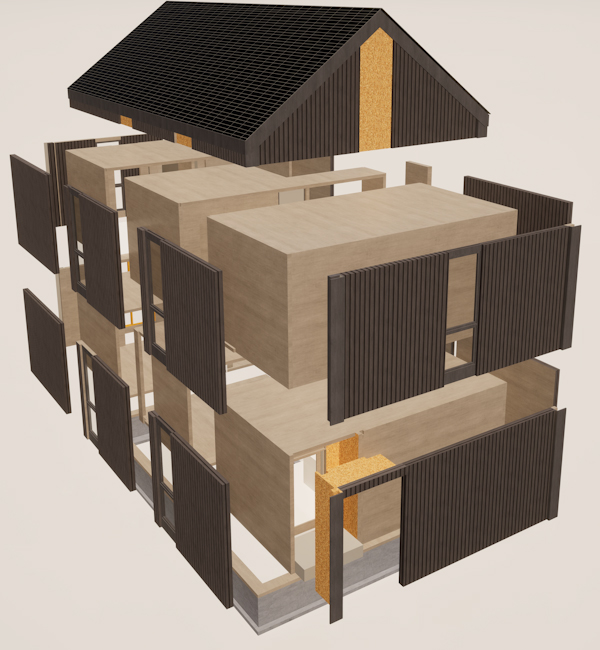Making Homes Energy Affordable and Reliable: PNNL Researchers Figuring Out How to Do Both

Researchers at PNNL collected and analyzed data from prototypes of cold climate heat pumps installed in homes like this one in Alaska to determine if they would operate efficiently in real-world conditions.
(Photo: Cordova Electric Cooperative)
This time of year, many of us are preparing our homes for holiday gatherings. But for some researchers at the Department of Energy’s Pacific Northwest National Laboratory, working to make homes more energy efficient and environmentally friendly is a year-long endeavor.
For example, PNNL researchers are designing and performing rigorous field testing of the next generation of affordable, reliable heat pumps to help bring them to market.
Heat pumps are significantly more efficient than other forms of electric or gas heating and offer efficient cooling in the summer, lowering utility bills year-round. However, their efficiency typically declines when temperatures drop below 40 degrees Fahrenheit. Designing a cost-effective heat pump for cold climates would significantly spur deployment of these energy-saving systems. Toward this end, DOE recently challenged manufacturers to build advanced heat pumps that efficiently operate at 5 degrees Fahrenheit or colder.
Eight leading manufacturers built prototypes according to specifications developed by PNNL researchers and their partners. After they all passed laboratory tests, PNNL and the manufacturers teamed to install the pre-commercial units in 23 homes in the U.S. and Canada. Researchers collected and analyzed a full year of data using PNNL’s high-performance computing capabilities. They also tested the prototypes’ demand-response capabilities, which allow the units to manage energy usage based on signals from the utility company that might allow consumers to save money or help stabilize the grid.
In addition to showing that the prototypes met efficiency and performance targets under a variety of conditions, the field test data are helping manufacturers improve their cold climate heat pumps as they begin selling them commercially. The data and consumer feedback are publicly available to other heat pump manufacturers, utilities, regulators and policy makers. PNNL also developed a free, easy-to-use online decision tool that guides contractors and installers through proper sizing and installation—the keys to maximizing consumer comfort and energy savings.
Looking ahead, researchers expect to leverage this project’s analytical methods and data protection and validation approaches for future field tests of pre-commercial technologies. For example, PNNL scientists are exploring novel, inexpensive leak-detection sensors for new refrigerants.
Beyond efforts to increase efficiency in today’s homes, PNNL also is pursuing a more futuristic concept known as the circular home. In this context, circular refers to homes that are designed to be deconstructable and reconstructable, eliminating waste and greenhouse gases generated throughout the home’s life cycle.

A circular home would minimize the carbon associated with its building materials, including the emissions generated during the extraction and transportation of its raw materials, as well as those resulting from the manufacturing and construction processes.
In a partnership with Virginia Tech and Green Canopy NODE, a Seattle-based company that specializes in sustainable modular homes, researchers are exploring materials and methods that would allow building components to be recycled or repurposed. They also are looking at new bio-based building materials and advanced manufacturing techniques, such as cross-laminated timber and pop-up manufacturing facilities.
Because circular homes also could incorporate on-site electricity generation and energy storage, PNNL is conducting energy simulations and optimizing the design of those options with respect to building performance.
Leveraging PNNL’s strengths in energy efficiency and building science, PNNL researchers developed software that quantifies the impacts of the materials and processes used in circular homes by integrating them into the whole-building life-cycle analysis. This allows architects, engineers and environmental experts to incorporate sustainability goals into the design process, along with other factors like cost and aesthetics. Researchers also are analyzing the future energy and life-cycle performance of homes based on different mixes of energy sources on the grid to maximize emissions reductions throughout the entire life cycle.
It is often said—and sung—that there’s no place like home for the holidays. For some of your friends and neighbors, there is no place like PNNL to make those homes even better. And on a personal note, I hope you all had a safe and joyful Thanksgiving!
Steven Ashby, director of Pacific Northwest National Laboratory, writes this column monthly. To read previous Director's Columns, please visit our Director's Column Archive.
Published: December 2, 2024